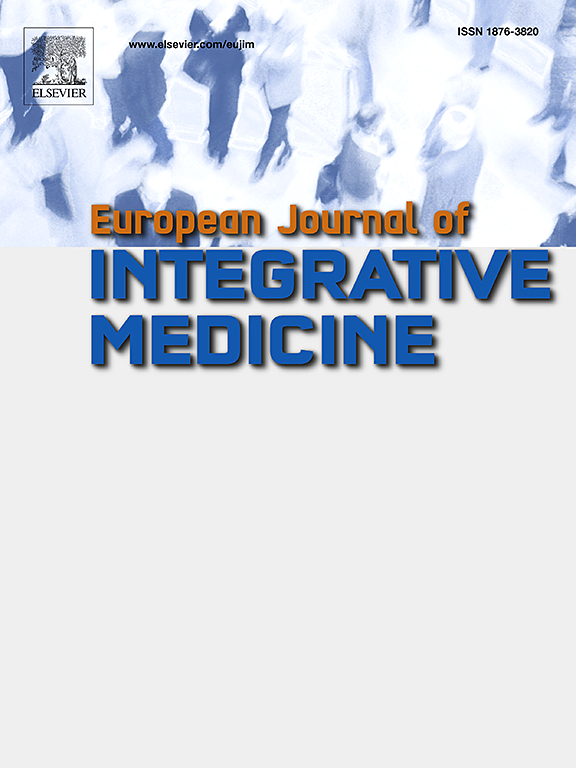枸橼酸钠通过调节乳酸代谢和抑制调节性t细胞分化对肝癌的抑制作用
IF 1.7
4区 医学
Q3 INTEGRATIVE & COMPLEMENTARY MEDICINE
引用次数: 0
摘要
黄芩苷是一种从黄芩中提取的活性类黄酮,具有调节细胞代谢的作用。越来越多的证据表明,在体外和体内,沃戈宁抑制调节性t细胞(Treg)分化并调节免疫反应。然而,潜在的分子机制仍然知之甚少。我们之前的研究结果表明,乳酸是肝细胞癌(HCC)细胞糖酵解的代谢副产物,可促进naïve CD4+ T细胞向Tregs的分化。方法在乳酸存在的情况下,观察枸枸素(1.25、5、20 μg/mL)对naïve CD4+ t细胞分化的影响。流式细胞术分析Tregs比例。western blotting (WB)和RT-PCR分别检测TGF-β、p-Smad2、p-Smad3、LDHA、p-mTOR、HIF-1α、ATP5B、FOXP3蛋白和mRNA的表达水平。ELISA法测定血清IL-10、α-KG、2-HG水平。为了进一步评估体内疗效,我们通过皮下注射H22细胞建立小鼠肝癌移植模型。接种后第7天,分别给小鼠注射12.5或25 mg/kg的沃戈宁。三周后,老鼠被安乐死。通过HE染色对肿瘤进行组织学分析,同时通过免疫组织化学和流式细胞术评估CD4+和CD8+ t细胞群。ELISA法测定LDHA酶活性、细胞内外乳酸和葡萄糖浓度。RT-PCR检测FOXP3、IL-10 mRNA表达水平。结果补充乳酸显著增加细胞因子刺激(抗cd3、抗cd28和TGF-β)后Treg的分化。相反,wogonin治疗显著且剂量依赖性地降低Treg分化和LDHA表达。通过抑制剂筛选,c-Myc被确定为wogonin的关键分子靶点。机制上,wogoonin抑制c-Myc活性,进而下调LDHA表达和酶活性,减少2-羟基戊二酸(2-hydroxyglutarate, 2-HG)的异常积累,使2-HG/α-KG比值正常化,最终降低FOXP3和IL-10的表达。结论swogonin通过抑制c- myc介导的LDHA表达,破坏2-HG/ATP5B/mTOR/HIF-1α信号通路,抑制Treg分化,发挥抗hcc作用。鉴于其重塑免疫抑制肿瘤微环境的潜力,进一步研究其与PD-1/PD-L1抑制剂的联合是有必要的。本文章由计算机程序翻译,如有差异,请以英文原文为准。
Inhibitory effects of wogonin on hepatocellular carcinoma through modulation of lactate metabolism and suppression of regulatory T-cell differentiation
Introduction
Wogonin, an active flavonoid derived from the traditional Chinese medicinal herb Scutellaria baicalensis, has been reported to regulate cellular metabolism. Increasing evidence suggests that wogonin inhibits regulatory T-cell (Treg) differentiation and modulates immune responses both in vitro and in vivo. However, the underlying molecular mechanisms remain poorly understood. Our previous findings demonstrated that lactic acid, a metabolic byproduct of glycolysis in hepatocellular carcinoma (HCC) cells, promotes the differentiation of naïve CD4+ T cells into Tregs.
Methods
The effects of wogonin (1.25, 5, and 20 μg/mL) on naïve CD4+ T-cell differentiation were examined in the presence of lactic acid. The proportion of Tregs was analyzed using flow cytometry. Protein and mRNA expression levels of TGF-β, p-Smad2, p-Smad3, LDHA, p-mTOR, HIF-1α, ATP5B, and FOXP3 were measured by western blotting (WB) and RT-PCR, respectively. Levels of IL-10, α-KG, and 2-HG were quantified using ELISA. To further assess in vivo efficacy, a mouse hepatoma transplantation model was established by subcutaneous injection of H22 cells. Seven days after inoculation, mice were treated with wogonin (12.5 or 25 mg/kg). After three weeks, mice were euthanized. Tumors underwent histological analysis by HE staining, while CD4+and CD8+ T-cell populations were assessed via immunohistochemistry and flow cytometry. LDHA enzyme activity, intracellular and extracellular lactate and glucose concentrations were measured by ELISA. FOXP3 and IL-10 mRNA levels were evaluated by RT-PCR.
Results
Supplemental lactic acid significantly increased Treg differentiation following cytokine stimulation (anti-CD3, anti-CD28, and TGF-β). Conversely, wogonin treatment significantly and dose-dependently reduced Treg differentiation and LDHA expression. Through inhibitor screening, c-Myc was identified as a critical molecular target of wogonin. Mechanistically, wogonin suppressed c-Myc activity, subsequently downregulating LDHA expression and enzyme activity, reducing abnormal accumulation of 2-hydroxyglutarate (2-HG), normalizing the 2-HG/α-KG ratio, and ultimately decreasing FOXP3 and IL-10 expression.
Conclusions
Wogonin suppresses Treg differentiation and exerts anti-HCC effects by inhibiting c-Myc-mediated LDHA expression and disrupting the 2-HG/ATP5B/mTOR/HIF-1α signaling pathway. Given its potential to reshape the immunosuppressive tumor microenvironment, further investigation into its combination with PD-1/PD-L1 inhibitors is warranted.
求助全文
通过发布文献求助,成功后即可免费获取论文全文。
去求助
来源期刊

European Journal of Integrative Medicine
INTEGRATIVE & COMPLEMENTARY MEDICINE-
CiteScore
4.70
自引率
4.00%
发文量
102
审稿时长
33 days
期刊介绍:
The European Journal of Integrative Medicine (EuJIM) considers manuscripts from a wide range of complementary and integrative health care disciplines, with a particular focus on whole systems approaches, public health, self management and traditional medical systems. The journal strives to connect conventional medicine and evidence based complementary medicine. We encourage submissions reporting research with relevance for integrative clinical practice and interprofessional education.
EuJIM aims to be of interest to both conventional and integrative audiences, including healthcare practitioners, researchers, health care organisations, educationalists, and all those who seek objective and critical information on integrative medicine. To achieve this aim EuJIM provides an innovative international and interdisciplinary platform linking researchers and clinicians.
The journal focuses primarily on original research articles including systematic reviews, randomized controlled trials, other clinical studies, qualitative, observational and epidemiological studies. In addition we welcome short reviews, opinion articles and contributions relating to health services and policy, health economics and psychology.
 求助内容:
求助内容: 应助结果提醒方式:
应助结果提醒方式:


